By Eric Lindstrom
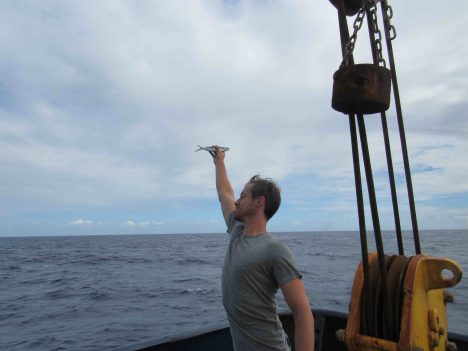
Sam Levang from WHOI catches a flying fish in flight.
I figured I would go off topic today and discuss a disturbing observation by someone who has spent more than half a lifetime going to sea. This is my personal opinion and does not reflect any policy or perspective of NASA. However, those of you on land really need to know that humans have had an enormous impact on the large life forms in the ocean. Sure, you probably know about how we took whales to the brink of extinction, but what about the fish on your dinner table. Do you really know how much is left in the sea?
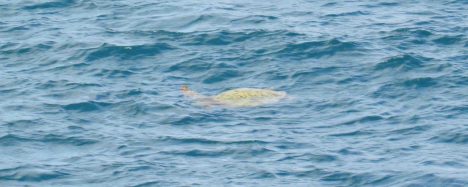
A sea turtle near Honolulu.
First, to minimize stating a bunch of boring facts and figures, I give you some brief but informative links below to research for yourself. This blog post is more of an emotional statement of alarm from my personal experience than that of a fisheries biologist or an expert on marine biota of any kind.
I became an observer of marine life from a very young age. I was raised in Seal Beach, California in the 1950’s when sea lions still roamed the beach. They have long departed. Most of my oceanographic life was spent in the tropical Pacific Ocean from late 1970s to present. My experience tells me has been an enormous change in the frequency of sightings of marine organisms from shipboard during those years. In the 1970s and 1980s it was a daily occurrence to see sharks, tuna, squid, and birds. Now, in the 21st century, we are lucky to see ANY of the former and few birds. Flying fish are still around but disturbingly little else swims by the ship during shipboard work in recent years. To put this in land-loving terms it feels like a rainforest filled with life is replaced by a desert of bleak lifeless sand. Sadly, this trend has been clear to me for decades and is substantiated in many ways by scientific studies. I particularly note that my personal observations coincide in time with the dramatic increase in tropical fisheries from the 1980s. Rapid depletion of large and visible marine organisms at the top of the food chain has been well-documented. A good book on this subject is “An Unnatural History of the Sea” By Callum Roberts.
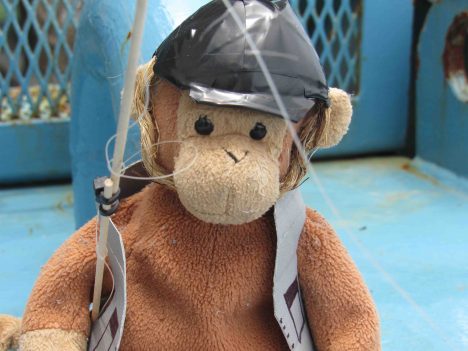
Monkey geared up for fishing.
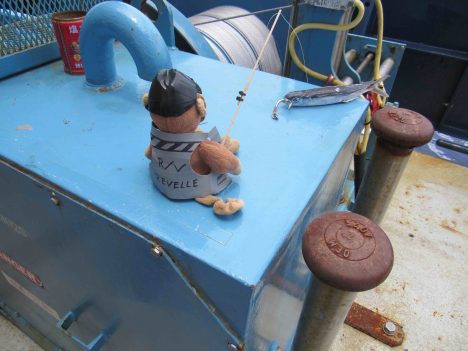
Monkey actually caught a fish!
Another aspect of the alarming trends in the ocean over recent decades is the growing abundance of marine debris, particularly plastics in the far reaches of the open ocean. I will devote a future blog to this subject (as I did during SPURS-1)
I do not wish to leave you with only a picture of doom and gloom. We should all pitch in to alleviate pressure on ocean ecosystems. The National Oceanic and Atmospheric Administration has created Fish Watch to help guide concerned consumers to sustainable seafood choices. I urge all who follow my blog to become concerned consumers! Also, any lessons from your past about the limitless abundance of the ocean should certainly be buried and replaced by thoughts about care and stewardship of precious and limited marine resources.
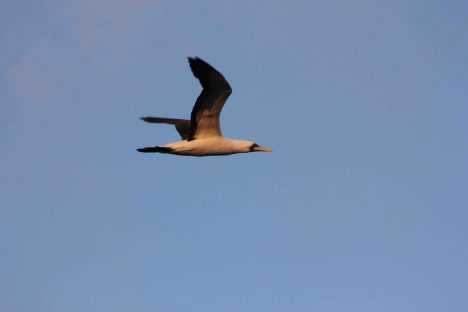
Masked booby.
References:
Overfishing (Wikipedia).
Marine Fisheries — The State of the Affairs.
Tags: marine ecology, ocean life, oceanography, overfishing, SPURS2




It is a sad state of affairs that people in this country, unless they work in the commercial fishery industry, have no idea of the barren oceans surrounding our land mass. I lived in the Boston area for 10 years, and, every year I took my son on a “whale watching” trip. They were amazing. One of the things I learned during those trips (all had Naturalists, etc., as guides) I never really thought of the name “Cape Cod” as being descriptive. During the early days of our settlement on the NE Coast there was abundant fish life, and, hence the name “Cape Cod”. Nowadays you’d be hard pressed to find a COD. They were fished almost to extinction before the government (I assume) stepped in. It wasn’t a hard persuasion, the fishermen weren’t catching any fish. So they switched to swordfish and soon found more efficient ways of catching them. The same thing was about to happen before limits were established.
BTW, we did see whales and dolphins. The baleen whales had plenty to eat, not so much for the dolphins – I think they hung around to see the stupid humans destroying our planet! To this day I refuse to order swordfish in a restaurant.
Dear Helen,
Thank you for your comment and observations. For centuries, the excuse for “where did the fish go?” after much concerted fishing effort, was “They moved to another location!” Today, when we observe the ocean globally, the truth is more obvious, that we have taken much of the higher levels of the food chain out of the ocean. The depletion of wild catches is being made up for by very rapid increases in farmed fishes.
Regards
Eric